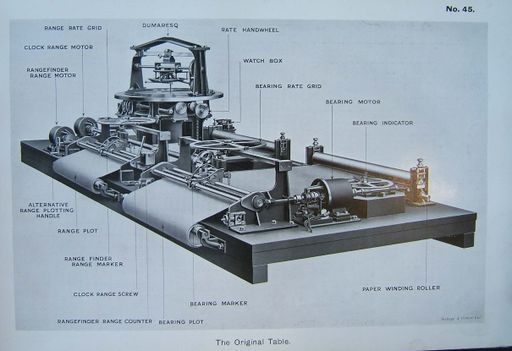Difference between revisions of "Original Dreyer Table"
(move from old Bibliography Templates to new, Citable Source Templates) |
(move from old Bibliography Templates to new, Citable Source Templates) |
||
| Line 32: | Line 32: | ||
==Bibliography== | ==Bibliography== | ||
<small> | <small> | ||
| − | *{{ | + | *{{DreyerTableH1918}} |
*{{BrooksDreadnoughtGunnery}} | *{{BrooksDreadnoughtGunnery}} | ||
*{{THArgoAndDreyer}} | *{{THArgoAndDreyer}} | ||
Revision as of 20:50, 14 September 2012

The table had the dumaresq at the left rear of the table. This was changed to be front and center in the Mark III Dreyer Table which was based on this prototype.
The Original Dreyer Table was the prototype for Frederic Dreyer's fire control table. Only one was built, and it followed Dreyer about and ate (of course) table scraps.
Dreyer's original table illustrated the fundamental basis of Dreyer's approach to gunnery: plotting ranges and bearings versus time and using a dumaresq, range clock and other accessories to help relate the data to each other and develop a continuous hypothesis of range and deflection to send to the guns.
The original table was a successful but incremental step from individual use of 2 plots and a dumaresq and Vickers Range Clock, but the integration helped reduce latency and eliminate errors. The bad news is that there was certainly more that could be done, and some of the most easily addressable shortcomings were given a quick treatment
Development
In 1906 and early 1907, when serving as a Lieutenant aboard Exmouth, Dreyer, helped intermittently by his brother John, conceived and proposed fire control methods based on plotting ranges transmitted from a rangefinder against time and evaluating the slope of the trend suggested to calculate range rate.[1] One of the series of "Time and Range" designs that resulted was evaluated aboard Revenge by Lieutenant A. T. Johnstone of H.M.S. Excellent in autumn 1907. These tests were competitive with a virtual course plotting system from Arthur Pollen.
During their effort, Dreyer's team made the first-ever use of dumaresq cross-cuts.[2] It was not until a successful test in Superb of time and range plotting being used in conjunction with a range clock in 1909-1910 that the method enjoyed strong support within the navy.[3]
In late March 1914, the single table was aboard Hercules.[4]
Dumaresq
Judging from the plate, the dumaresq seemingly had no gyrocompass input.
Range Clock
Bearing Clock
The original table lacked a bearing clock.
Spotting Corrector Gear
The original table lacked spotting corrector gear.
See Also
Footnotes
Bibliography
- Template:DreyerTableH1918
- Template:BrooksDreadnoughtGunnery
- Dreyer, Frederic; Usborne, Cecil through Gunnery Branch, Admiralty. (1913). Pollen Aim Corrector System, Part I. Technical History and Technical Comparison with Commander F. C. Dreyer's Fire Control System. P. 1024. in Admiralty Library, Portsmouth.